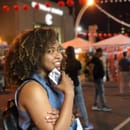You might have noticed a couple of “vintage” items becoming popular again recently. Aside from fashion (like your beloved mom jeans and plaid everything), you’ve probably noticed vinyl records, cassette tapes, polaroids and old gaming systems on your Instagram feed or in your local Urban Outfitters. Apparently, there’s a huge market among young adults for this retro technology today which fascinates me. It seems like we’re able to do everything with our phones and computers nowadays so why bother, right? As a fun little project this past summer, I decided to understand the hype for myself and delved deeper into one retro technology: film cameras.
Photography is one of my favorite hobbies. I try to practice it beyond the capabilities of my phone and the automatic settings of my camera but by no means am I an expert with it. This was one of the reasons why I hesitated to get a film camera. It seemed like there was such a steep learning curve for it! Alas, after hours of research and days poring over whether or not I should get one, I purchased a vintage 35 mm film camera (a Minolta SRT-101 with a 50mm lens if you’re interested). After buying a few rolls of film, watching a couple of Youtube tutorials and fiddling around with the camera, I was ready to get started.
There are many things that are different in taking pictures with a film camera versus taking one with a digital camera or on a phone. One big difference is the need to load your camera with a roll of film before you can get started. Film rolls typically come in 12, 24 and 36 exposures (which is the number of shots you get) per roll so you are limited with the number of shots you can take. Additionally, you don’t have a screen to see if the pictures you’re taking are actually decent or not. All you have is a viewfinder (the little eyepiece that you use to see your subject), your manual controls (if using a manual camera) and your shutter. You kind of just shoot your shot and hope for the best!
I first took the camera to test out during a picnic at a scenic park for a friend’s birthday, just days after getting it. With that first roll of film, I was so scared to waste any shots since they were so limited but just took the day to learn and get used to how the camera works. Unfortunately, I have no pictures to show from that first roll because the film got stuck and got ruined while unwinding. That would never happen if I used a digital camera! Sad and discouraged, I decided to give film photography another chance by taking it with me to upcoming trips to Florida and Montreal, ditching my more reliable DSLR in the process to force myself to use it.
Another big difference in using film photography is the need to have the film developed. There I was, curious to see how the pictures were going to look and perhaps share them if they turned out well, but processing film takes time. While waiting, I was a little worried that the pictures would turn out terrible so I didn’t expect much from it, especially after my less than stellar first try. Thankfully, I had much better luck the second time around! I have never been more excited and happy to see pictures that I’ve taken than when I saw that first batch of film digitally developed. Personally, I thought that it looked and seemed so different from my usual photos.
Shooting with film cameras this past summer made me appreciate photography even more as an art form. We often take it for granted with the ability to take a quick snap with our phones. With a film camera, I didn’t feel pressured with the immediacy to post all the photos on Instagram right away since the film had to be processed first. Additionally, being forced to take pictures with a limited number of shots made me think about the moment I was capturing and its value. Because every shot counted, I had to shoot with intent and purpose. With the film camera, I was taking pictures just for pure personal enjoyment and it made each moment captured all the more special. If you’re into photography, I definitely recommend trying it out if you’re able to. It’s so much fun and it is such a different experience that’s worth trying out!
All photos are courtesy of Dianne Yvonne Victor



